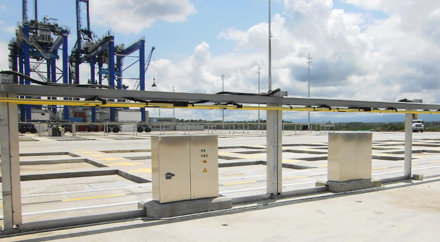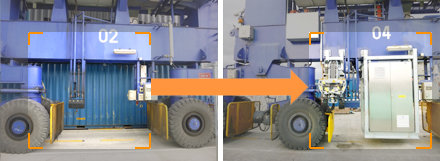Recommend
Remove File
Remove document <span id="remove-document-name"></span> from <span id="remove-cart-name"></span>?
Steel structure, conductor rail system with a total length of more than 10 kilometers and electrification of 25 container blocks with seven existing and six new container cranes with Drive-In L solution
Buenaventura/Weil am Rhein, May 2016. Conductix-Wampfler, the world's leading manufacturer of systems for energy and data transmission to mobile consumers, has successfully realized another major project for electrifying Rubber Tyred Gantry cranes (RTGs). The company modified seven diesel powered RTGs manufactured by Shanghai Zhenhua Port Machinery (ZPMC) at TCBuen at the Colombian terminal belonging to the Spanish Grup TCB, and has also supplied six Drive-In L units for new RTGs manufactured by Konecranes as part of the terminal's expansion. Conductix-Wampfler installed the steel structure and overall 10,400 meters of conductor rail systems. The project took 19 months and was completed in the fall of 2015.
"We fitted a total of 25 blocks with the E-RTG Drive-In L solution, each of which was between 100 meters and 130 meters long. The Single-Side and Back-to-Back systems translated into more than ten kilometers of conductor rails, 50 Drive-In zones, and 25 pillar boxes fitted over a total system length of 2,900 meters", explained Andreas Burkart, who is in charge of the project at Conductix-Wampfler. In order to convert the 440V voltage to the 400V required by the ZPMC RTG's, each RTG had to be fitted with two transformers. As well as installing the Drive-In L units, the RTGs also had to be equipped with a switch cabinet, control system, auto-steering system and reinforcement for the sill beam for holding the Drive-In L units and transformers.

Reduction of maintenance and downtime
Thanks to its compact design, the Drive-In L – regardless of the model of RTG and the position of the diesel assembly – can be installed on both sides of the RTG under the sill beam of the RTG. This makes the solution the most flexible of its kind currently on the market. The entry and exit times of the RTG are less than 20 seconds with Drive-In L. The short entry zone also makes it possible to supply the RTG with power right from the first row of containers. Compensation is also ensured for tolerances that occur during travel of the RTG in container blocks or due to lifting and lowering. Coupling into the conductor rail with Drive-In L is entirely automatic and controlled exclusively from the cabin of the RTG. This eliminates the need for any ground personnel to switch blocks, which significantly increases safety at the terminal.

"Conductix-Wampfler's system has proven to be the best alternative to using diesel-operated systems, especially given the challenging climatic conditions of the Colombian coast", emphasizes Eduardo Montero from Grup TCB. Apart from being the perfect answer to the terminal's needs, the system is also extremely flexible, which means that it can be further expanded as the need arises. "In addition to the system's countless benefits, we have also found Conductix-Wampfler to be a highly reliable partner with extensive experience in the crane industry and an efficient global service structure."
Challenges Mastered with Success
The complex electrification project in Buenaventura presented a number of challenges for Conductix-Wampfler. Since the ECO RTGs manufactured by ZPMC are fitted with Siemens ECO1 controls and ELFA drives, the conversion could only be realized with direct collaboration with Siemens. "The electrification work often had to be put on hold due to the heavy rainfall, extremely high humidity and temperatures, and concurrent work to expand the terminal", remembers Christian Nunez, Conductix-Wampfler's Sales Manager for Latin America. The construction of the steel structure, and installation and conversion work was performed under the supervision of Conductix-Wampfler Weil am Rhein. The two local partner companies who performed the steel construction work and RTG modifications received active support from Conductix-Wampfler Brazil. "For us, the project in Buenaventura was a great example of efficiency and perfect for preparing us for our other E-RTG project for the Brazilian terminal of Portonave", comments José Roberto, Conductix-Wampfler Brazil's Service Supervisor.
Higher productivity and climate protection
"Thanks to the electrification, we have been able to significantly reduce both our energy consumption and noise pollution at the container terminal TCBuen since October last year. This has enabled us to make significant progress concerning our responsibility to protect both the environment and our personnel as best we can", further explains Montero. However, the company is also recording an increase in productivity, which is due in part thanks to a decrease in incidents and waiting times. Conductix-Wampfler assumes that, thanks to the many advantages of E-RTGs, diesel-operated cranes will only be employed in areas where it is not technically possible to supply electricity in future. "The completion of this large project in Columbia has enabled us to further consolidate our position as a pioneer and leader in the market", concludes Burkart.